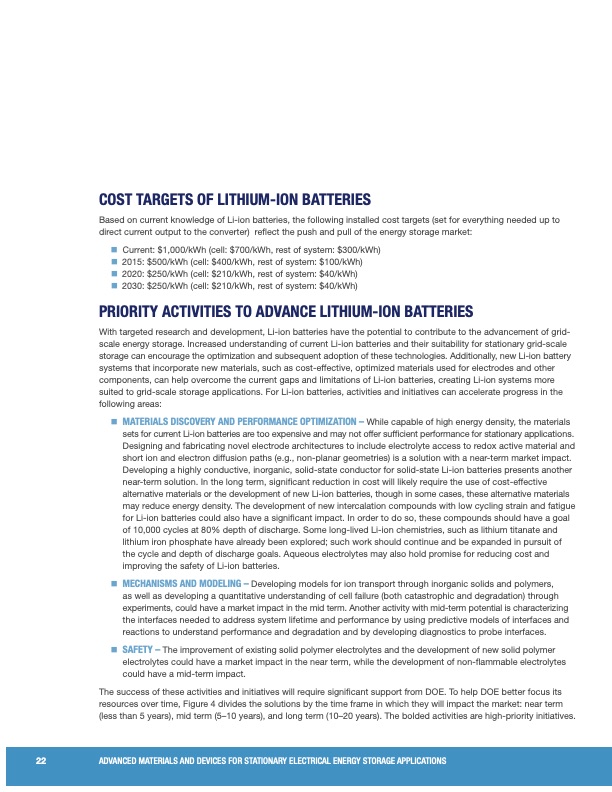
PDF Publication Title:
Text from PDF Page: 026
COST TARGETS OF LITHIUM-ION BATTERIES Based on current knowledge of Li-ion batteries, the following installed cost targets (set for everything needed up to direct current output to the converter) reflect the push and pull of the energy storage market: n Current: $1,000/kWh (cell: $700/kWh, rest of system: $300/kWh) n 2015: $500/kWh (cell: $400/kWh, rest of system: $100/kWh) n 2020: $250/kWh (cell: $210/kWh, rest of system: $40/kWh) n 2030: $250/kWh (cell: $210/kWh, rest of system: $40/kWh) PRIORITY ACTIVITIES TO ADVANCE LITHIUM-ION BATTERIES With targeted research and development, Li-ion batteries have the potential to contribute to the advancement of grid- scale energy storage. Increased understanding of current Li-ion batteries and their suitability for stationary grid-scale storage can encourage the optimization and subsequent adoption of these technologies. Additionally, new Li-ion battery systems that incorporate new materials, such as cost-effective, optimized materials used for electrodes and other components, can help overcome the current gaps and limitations of Li-ion batteries, creating Li-ion systems more suited to grid-scale storage applications. For Li-ion batteries, activities and initiatives can accelerate progress in the following areas: n MATERIALS DISCOVERY AND PERFORMANCE OPTIMIZATION – While capable of high energy density, the materials sets for current Li-ion batteries are too expensive and may not offer sufficient performance for stationary applications. Designing and fabricating novel electrode architectures to include electrolyte access to redox active material and short ion and electron diffusion paths (e.g., non-planar geometries) is a solution with a near-term market impact. Developing a highly conductive, inorganic, solid-state conductor for solid-state Li-ion batteries presents another near-term solution. In the long term, significant reduction in cost will likely require the use of cost-effective alternative materials or the development of new Li-ion batteries, though in some cases, these alternative materials may reduce energy density. The development of new intercalation compounds with low cycling strain and fatigue for Li-ion batteries could also have a significant impact. In order to do so, these compounds should have a goal of 10,000 cycles at 80% depth of discharge. Some long-lived Li-ion chemistries, such as lithium titanate and lithium iron phosphate have already been explored; such work should continue and be expanded in pursuit of the cycle and depth of discharge goals. Aqueous electrolytes may also hold promise for reducing cost and improving the safety of Li-ion batteries. n MECHANISMS AND MODELING – Developing models for ion transport through inorganic solids and polymers, as well as developing a quantitative understanding of cell failure (both catastrophic and degradation) through experiments, could have a market impact in the mid term. Another activity with mid-term potential is characterizing the interfaces needed to address system lifetime and performance by using predictive models of interfaces and reactions to understand performance and degradation and by developing diagnostics to probe interfaces. n SAFETY – The improvement of existing solid polymer electrolytes and the development of new solid polymer electrolytes could have a market impact in the near term, while the development of non-flammable electrolytes could have a mid-term impact. The success of these activities and initiatives will require significant support from DOE. To help DOE better focus its resources over time, Figure 4 divides the solutions by the time frame in which they will impact the market: near term (less than 5 years), mid term (5–10 years), and long term (10–20 years). The bolded activities are high-priority initiatives. 22 ADVANCED MATERIALS AND DEVICES FOR STATIONARY ELECTRICAL ENERGY STORAGE APPLICATIONSPDF Image | Devices for Stationary Electrical Energy Storage Applications

PDF Search Title:
Devices for Stationary Electrical Energy Storage ApplicationsOriginal File Name Searched:
AdvancedMaterials_12-30-10_FINAL_lowres.pdfDIY PDF Search: Google It | Yahoo | Bing
Turbine and System Plans CAD CAM: Special for this month, any plans are $10,000 for complete Cad/Cam blueprints. License is for one build. Try before you buy a production license. More Info
Waste Heat Power Technology: Organic Rankine Cycle uses waste heat to make electricity, shaft horsepower and cooling. More Info
All Turbine and System Products: Infinity Turbine ORD systems, turbine generator sets, build plans and more to use your waste heat from 30C to 100C. More Info
CO2 Phase Change Demonstrator: CO2 goes supercritical at 30 C. This is a experimental platform which you can use to demonstrate phase change with low heat. Includes integration area for small CO2 turbine, static generator, and more. This can also be used for a GTL Gas to Liquids experimental platform. More Info
Introducing the Infinity Turbine Products Infinity Turbine develops and builds systems for making power from waste heat. It also is working on innovative strategies for storing, making, and deploying energy. More Info
Need Strategy? Use our Consulting and analyst services Infinity Turbine LLC is pleased to announce its consulting and analyst services. We have worked in the renewable energy industry as a researcher, developing sales and markets, along with may inventions and innovations. More Info
Made in USA with Global Energy Millennial Web Engine These pages were made with the Global Energy Web PDF Engine using Filemaker (Claris) software.
Sand Battery Sand and Paraffin for TES Thermo Energy Storage More Info
| CONTACT TEL: 608-238-6001 Email: greg@infinityturbine.com | RSS | AMP |